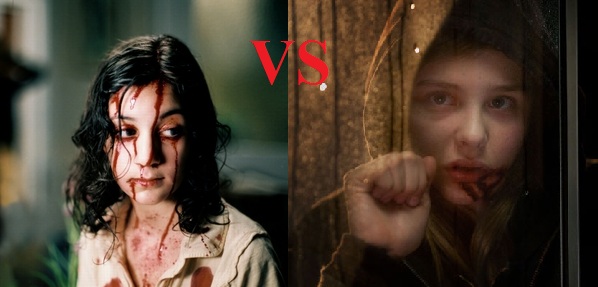Remakes are nothing new. From the silent era onward, filmmakers have returned again and again to the same stories, re-interpreting them and updating them either for the sake of modernization, to expose them to a broader audience or to just make more money. We modern film geeks tend to roll our eyes and groan cynically when a new remake comes down the pike, but the fact of the matter is that when done right there are few things as satisfying as a seeing a story we love get a good cinematic spit-shine. Remakes are a part of the grand tradition of storytelling and cinema history, and love them or hate them, they’re here to stay.
But in the last decade, the term “remake” has become something of a dirty word, and as a result Hollywood spin doctors and internet journalists have given us the new terms “reboot” and “re-imagining”. Do these terms actually have meaning, or are they just empty buzzwords? The mission statement of this ongoing column will be to answer that question by comparing an original film to a re-do and determining if the newer version fits one of the following definitions:
Remake: A straight re-telling of a story for the purpose of updating it for a contemporary audience, or making it accessible to a different culture or region.
Reboot: A course correction done with the purpose of restarting a franchise. A reset. Fealty to the original story or film is not a priority.
Re-Imagining: A re-telling of a story, but only in the broadest sense. Characters and some story elements may be retained, but mostly plot and story have been repurposed.
I also will make a judgment call on which version is superior. Some controversy may ensue.
LET THE RIGHT ONE IN VS. LET ME IN
The story: A boy on the cusp of adolescence finds growing up difficult in his snowbound suburban community. He is bullied mercilessly at school, his parents are separated and he has begun to develop sociopathic tendencies as a result. Hope seems to arrive when a girl his age moves into the apartment next door to the one he shares with his mother. But things are not as they seem with the girl. She is never seen during the day, is impervious to the cold, has heightened abilities and sometimes is sickly and smells bad. Her adult keeper, a middle aged man, goes out at night where he drugs victims and drains them of their blood, which he brings home with him. Meanwhile, the girl helps the boy develop the courage to stand up to the bullies, and the two form a unique and lovely bond. One night the girl’s adult keeper gets sloppy and is caught, and when the girl turns to the boy for help he comes to realize that the “girl” is a vampire. The other people in the community realize that something sinister is afoot, and as the net tightens around the vampire girl, the boy struggles whether to protect her or to allow her to be vanquished.
So what’s the deal?: Just to let y’all know where I stand on this – Let the Right One In is my favorite story of the last decade, maybe more. I love the book, the Swedish film directed by Tomas Alfredson is in my top 5 films of all time and I even like the American version a lot. In my opinion it is the best vampire story of all time, is one of the greatest coming of age stories of all time, and is just a great piece of drama and fiction. I firmly believe that it will be seen as a classic genre work in coming years (it pretty much already is), and the Swedish film may be seen as the greatest piece of genre cinema of the ‘00’s. If you can’t appreciate Let the Right One In on some level, I have no use for your opinion. Sorry to sound like a snot but that’s just how it is. So yeah, you could say I’m a fan.
When the American version was announced, I was pissed. There were rumors that the story would receive a Twilight style rogering by aging the adolescent characters which would, in my opinion, completely nullify the coming-of-age element that is so crucial and central to the theme. But that didn’t happen. Then Matt Reeves was brought on board to direct, and although I wasn’t the world’s biggest Cloverfield fan, Reeves showed a love of the Swedish film and an understanding of its characters that gave me hope. He cast Chloe Moretz and Kodi Smit-McFee, two promising child actors, in the leads. The more that filtered in from the production, the more I began to warm up to the American take. If it had to exist (and this point is utterly debatable) at least it would be done as well as it could be. And in the end, I think it was. There are those who prefer the American version (titled Let Me In) to the Swedish one, and I don’t begrudge them that opinion. If setting the film in America makes the story more relatable to some, I’m OK with that. Sadly, audiences did not flock to Let Me In, which is too bad, because taken on its own, Matt Reeves’ version of the story is quite good and well worth a watch.
Reeves understands what strong material he has to work with and doesn’t do much in the way of re-jiggering. There are some changes; the setting is moved from Sweden to New Mexico, and though I think that Sweden is in essence a character in the original story and crucial to what makes Alfredson’s film so effective, the story is powerful enough to survive without it. Reeves tries to make 80’s America a real presence in Let Me In, but it doesn’t feel as organically bonded to the story as Sweden does to the book or the Swedish film. Still, it’s not a deal-breaker. Also in the not deal-breaker category is the changing of the kids’ names from Oskar and Eli to Owen and Abby. This decision seems more arbitrary, but sure, whatever. Those names are more American sounding, I get it. As far as adapting elements to appeal to a broader American audience, nothing Reeves does has any major impact or harm on the story. So far so good, Matt Reeves.
The biggest change from the Swedish film to the American one is the background characters. In the Swedish film, a lot of time is spent with the middle-aged alcoholic cronies whom the vampire Eli preys on, one of whom ultimately clues in on Eli and moves to investigate. In the American version these characters have been changed to neighbors living in the apartment complex who have very little screen time and mostly serve as victims. The investigating character is changed to an actual police detective, and though this change works it isn’t nearly as effective for me as the boozy Swedes. It’s the change that feels the most “American”; it’s as if American audiences can’t buy into a story in which there are murders without having some cop investigating them. Too much CSI Miami I guess. Reeves handles the subplot skillfully and adds some nice quirks (the detective thinks the murders are the work of a Satanic cult, which was a common 70’s/80’s hysteria), but ultimately the substitution is less nuanced and feels like the only element that has been “dumbed down”.
There are other minor quibbles I have with Let Me In. As good as Chloe Moretz is, she’s just too adorable and chipmunk-cheeked to buy as a scary vampire, and when she “vamps out” some wonky CG is employed. The CG effects in Alfredson’s film are subtle and the actress who plays Eli, Lina Leandersson, has an otherworldly quality that really sells the vampire angle for me. But you can make a case for Moretz’s more conventionally pretty features being more useful as a pre-teen vampire, so it really comes down to taste. I often wonder how I would feel about Let Me In if Let the Right One In didn’t exist as a film. I’m sure I would love it. But the very existence of Alfredson’s film makes Let Me In little more than a novelty to me; a nice alternate take on a story I love, but ultimately a redundancy.
So what about our terminology? Isn’t that why we’re here? Well folks, this one is easy I’m afraid. Reboot is out because this was never intended to start or continue a franchise. And despite the minor changes, this is too close to the Swedish film to be called a re-imagining. Much was made before the release of Let Me In that Reeves was drawing more from the book that the Swedish film for inspiration. Bull-shit. There are scenes that play out almost exactly like the Swedish film, and there’s no way Reeves didn’t watch it a thousand times before filming his version. He doesn’t add any of the controversial elements from the book, and aside from an extremely clever car-crash sequence, he doesn’t up the ante on Alfredson’s stunning presentation in any way and in fact draws heavily from it in terms of mood and atmosphere. Let Me In is a tried and true remake, no doubt about it.
Verdict: Remake.
Which one should I let in?: It should be obvious from my write-up, but as much as I do like Let Me In, it lacks much of the subtlety and grace of Let the Right One In. Let Me In is a good film, but Let the Right One In is a great film. However, I will allow the caveat that if you are the kind of person (you know who you are) who can’t enjoy a foreign film because it forces you to read or because you can’t relate to it not taking place in the good ole’ US of A, then by all means watch Let Me In.
Up next: Arthur (1981) vs. Arthur (2011)

